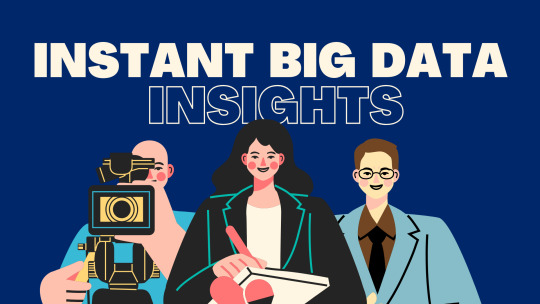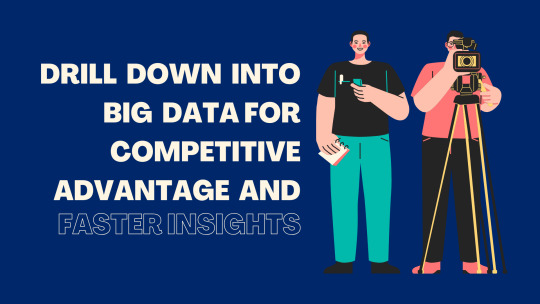#big data analytics tools
Text
Top 5 Benefits of Low-Code/No-Code BI Solutions
Low-code/no-code Business Intelligence (BI) solutions offer a paradigm shift in analytics, providing organizations with five key benefits. Firstly, rapid development and deployment empower businesses to swiftly adapt to changing needs. Secondly, these solutions enhance collaboration by enabling non-technical users to contribute to BI processes. Thirdly, cost-effectiveness arises from reduced reliance on IT resources and streamlined development cycles. Fourthly, accessibility improves as these platforms democratize data insights, making BI available to a broader audience. Lastly, agility is heightened, allowing organizations to respond promptly to market dynamics. Low-code/no-code BI solutions thus deliver efficiency, collaboration, cost savings, accessibility, and agility in the analytics landscape.
#newfangled#polusai#etl#nlp#data democratization#business data#big data#ai to generate dashboard#business dashboard#bi report#generativeai#business intelligence tool#artificialintelligence#machine learning#no code#data analytics#data visualization#zero coding
3 notes
·
View notes
Text
Shadi Rostami, SVP of Engineering at Amplitude – Interview Series
New Post has been published on https://thedigitalinsider.com/shadi-rostami-svp-of-engineering-at-amplitude-interview-series/
Shadi Rostami, SVP of Engineering at Amplitude – Interview Series
Shadi is SVP of Engineering at digital analytics leader Amplitude. She is a passionate, seasoned technology leader and architect experienced in building and managing highly proficient engineering teams. Prior to Amplitude, she was VP of Engineering at Palo Alto Networks. She has innovated and delivered several product lines and services specializing in distributed systems, cloud computing, big data, machine learning and security.
Amplitude is built on modern machine learning and generative AI technologies that enable product teams to build smarter, learn faster, and create the best digital experiences for their customers.
What initially attracted you to computer science and engineering?
I grew up in Iran and originally pursued a high school path that would enable a career in medicine, which was the path my father wanted me to take and the one my brother did. About a year and a half in, I decided it was not the path for me. Instead, I pursued engineering and ended up becoming the first girl in Iran to go to the Informatic Olympiad (IOI) and won the Bronze medal, a yearly competition for high school students around the world competing in math, physics, Informatics, and chemistry. That led me to pursue engineering at Sharif University of Technology in Iran and later get my Ph.D. in computer engineering at the University of British Columbia in Canada. After that, I worked for startups for a few years and then spent a decade at Palo Alto Networks, eventually becoming a VP responsible for development, QA, DevOps, and data science. Five years ago, I moved to Amplitude as the SVP of Engineering.
Could you discuss Amplitude’s core AI philosophy that AI should aid humans in improving their work rather than replacing them?
AI is quickly transforming almost every industry, and with the transformation comes questions about how companies will use the technology. We feel strongly about getting AI right. This belief led us to develop our customer-centric AI philosophy, which stands upon five main principles: (1) collaborative development and thought partnership, (2) data governance and user data protection, (3) transparency, (4) privacy, security, and regulatory compliance, and (5) customer choice and control. We know these principles are key as companies continue to adopt and test AI and eventually become truly data-driven. For our purposes, this means building AI tools that help people get to insights faster. When harnessed properly, these insights lead to faster, better decisions that drive bottom-line results. Using AI as a tool to complement human intelligence and creativity is where I see AI having its greatest impact.
Can you explain the concept of ‘data democracy’ in the context of today’s AI-driven business environment?
“Data democracy is driven by the knowledge that teams function better, faster, and more efficiently when they can access the right data insights at the right time. In today’s rapidly advancing AI-driven environment, teams can’t afford to wait days or weeks for data pulls. To mitigate this, companies must empower their teams to leverage data in a self-service way. Now, this doesn’t mean data chaos with no parameters. At the end of the day, bad data leads to bad AI. But with the right tools and processes in place, businesses can balance data democratization with data governance, enabling better business outcomes.”
What key shifts in organizational culture do you believe are essential for enabling true data democracy in the age of AI?
Establishing a true data democracy within your organization starts with two foundational culture shifts: providing the right, most accessible tools and conducting organization-wide efforts around data literacy. This means adopting self-service tools that allow non-technical team members, such as marketing or customer success teams, to not only access data but also analyze and take action on it. I believe self-service data analytics can and should fuel collaboration across teams, inspire curiosity and exploration, scale data literacy, and place a bias on action and impact. Also, it is important to spend joint efforts between the central data team and line of business teams to do continuous data governance to make sure data quality does not degrade over time.
In your experience, what are the most significant challenges organizations face in achieving data democratization, and how can they overcome these obstacles?
In the past, companies have tried to centralize data within one team of experts, leaving the rest of the organization reliant on this team to deliver analysis and key insights that may be critical to their day-to-day operations and decision-making. While democratizing data access is critical to solving this bottleneck, it can also be challenging. When I speak to data leaders about operationalizing self-service, it’s clear there is a spectrum. On one end, you have low setup tools for non-technical and line-of-business teams. Ultimately, these tools do not give the depth and breadth of answers that these teams need. On the other end, you have more technical tools for more technical teams. They are much more flexible in terms of analysis, but they are slow, and likely very few people can even use them. We refer to these tools as creating a “data breadline” … you’re always waiting for answers. Teams need a solution in the middle. Think out-of-the-box solutions that encourage, not inhibit, exploration and experimentation. With the proper tooling and team education, companies can more easily bridge the data democratization gap.
How crucial is data literacy in the process of data democratization, and what steps should companies take to improve it among their employees?
Fostering an environment of data democratization across your teams is a cultural challenge that requires education and company-wide buy-in. In my experiences with teaching data processes to non-technical members, the best way to develop these skills is through a combination of training and hands-on learning. I recommend developing a comprehensive training program to ensure employees feel comfortable and confident in the insights they’re pulling from their data. Make sure you are using a tool that does not prohibit non-technical users: for example, any tool that requires knowledge of SQL would marginalize folks without programming expertise. From there, provide opportunities for employees to dive in and start playing around with the data. Finally, implement a tool that fosters exploration and collaboration. The less people are working in silos, the more they can bounce ideas off of each other, leading to more illuminating insights. If you are a data professional teaching a non-technical team member, remember that you have spent years learning how to obtain and use data, so you think about it differently from the casual user. Be open to teaching others rather than doing everything yourself. Otherwise, you’ll never have any free time to do anything aside from answering people’s questions.
With the rapid evolution of data tools and generative AI technologies, how should companies adapt their strategies to stay ahead in data management and utilization?
Data governance is one of the main challenges companies still face, and it’s something every organization must nail down to empower meaningful AI and data experiences. AI is only as good as the data that powers it, and clean data leads to more impactful insights, happier users, and business growth. In this way, companies must be proactive about data cleanup and taxonomy, and there are opportunities to use generative AI to manage your AI governance and quality. For example, at Amplitude, we launched our AI-powered Data Assistant product last year, which offers intelligent recommendations and automation to make data governance seamless and help users take charge of data quality efforts.
How does Amplitude enable enterprises to better understand the customer journey?
Building great digital products and experiences is hard, especially in today’s competitive landscape. Today, many companies still don’t know who they’re building for or what their customers want. Amplitude helps businesses answer questions like, “What do our customers love? Where do they get stuck? What keeps them coming back?” through quantitative and qualitative data insights. Our platform helps businesses better understand the end-to-end customer journey by surfacing data to help drive the customer acquisition, monetization, and retention cycle. Today, more than 2,700 customers, including enterprise brands like Atlassian, NBC Universal, and Under Armour, leverage Amplitude to build better products.
Thank you for the great interview, readers who wish to learn more should visit Amplitude.
#ai#ai tools#AI-powered#amplitude#Analysis#Analytics#Atlassian#automation#Bias#Big Data#box#brands#bridge#Building#Business#business environment#Canada#career#challenge#chaos#chemistry#Cloud#cloud computing#Collaboration#collaborative#Companies#compliance#comprehensive#computer#Computer Science
0 notes
Text
https://www.webrobot.eu/travel-data-scraper-benefits-hospitality-tourism

The travel industry faces several challenges when using travel data. Discover how web scraping technology can help your tourism business solve these issues.
#travel#tourism#big data#web scraping tools#data extraction#hospitality#data analytics#datasets#webrobot#data mining#no code#ai tools
1 note
·
View note
Link
#data science#data analytics#data visualization#big data#machinelearning#statistics#data engineering#etl tools#etl
1 note
·
View note
Text
Top 5 Business Analytics Tools: Special Features, Limitations & Price

If you're here, you need no formal introduction to business analytics tools. You're probably also familiar with the difference between business analytics and business intelligence.
We'll give you an overview of some of the most popular (with good reason) data analytics tools, complete with products, special features, limitations, and prices.
Top 5 Business Analytics Tools
We've already covered Power BI, Tableau and Quicksight in a different article for business data analytics. In this one, we'll be focusing on other, equally good ones.
Talend
Talend is among the most powerful data integration ETL (Extract, Transform, Load) tools in the market. It has been named a leader in Gartner's Magic Quadrant for Data Integration Tools and Data Quality tools.
Its aim is to deliver accessible, clean and compliant data for everyone.
Talend is a software integration platform that provides various solutions for data management, data quality, data integration, data quality, and more. It has separate products for all these solutions.
0 notes
Text
Kyligence vs Apache Kylin: Big Data Analytics Tools Platform Comparison

Explore Kyligence as a top Apache Kylin alternative to big data analytics tools. Learn about the key features and benefits. Download our comparison guide today!
0 notes
Text
PREDICTIVE ANALYTICS ONLINE COURSE | DATA ANALYTICS FULL COURSE IN CHENNAI | DATA ANALYSIS COURSE NEAR ME | ONLINE MASTERS DEGREE ARTIFICIAL INTELLIGENCE | ARTIFICIAL INTELLIGENCE MASTERS DEGREE ONLINE | BEST MASTERS FOR ARTIFICIAL INTELLIGENCE IN CHENNAI | DATA VISUALISATION WITH POWER BI IN CHENNAI | MICROSOFT VISUALISATION COURSE IN CHENNAI | DATA VISUALISATION IN POWER BI | TABLEAU VISUAL ANALYTICS COURSE IN CHENNAI | VISUAL TABLEAU IN CHENNAI | DATA VISUALIZATION TOOLS FOR DATA SCIENCE | SIMPLE DATA SCIENCE PROJECT USING PYTHON IN CHENNAI | PYTHON BIG DATA CERTIFICATION IN CHENNAI | PYTHON DATA SCIENCE REAL TIME PROJECTS IN CHENNAI
Predictive Analytics Online Course, Data Analytics Full Course In Chennai, Data Analysis Course Near Me, Online Masters Degree Artificial Intelligence, Artificial Intelligence Masters Degree Online, Best Masters For Artificial Intelligence In Chennai, Data Visualisation With Power Bi In Chennai, Microsoft Visualisation Course In Chennai, Data Visualisation In Power Bi, Tableau Visual Analytics Course In Chennai, Visual Tableau In Chennai, Data Visualization Tools For Data Science, Simple Data Science Project Using Python In Chennai, Python Big Data Certification In Chennai, Python Data Science Real Time Projects In Chennai.
Visit : https://cognitec.in/testimonial
#PREDICTIVE ANALYTICS ONLINE COURSE#DATA ANALYTICS FULL COURSE IN CHENNAI#DATA ANALYSIS COURSE NEAR ME#ONLINE MASTERS DEGREE ARTIFICIAL INTELLIGENCE#ARTIFICIAL INTELLIGENCE MASTERS DEGREE ONLINE#BEST MASTERS FOR ARTIFICIAL INTELLIGENCE IN CHENNAI#DATA VISUALISATION WITH POWER BI IN CHENNAI#MICROSOFT VISUALISATION COURSE IN CHENNAI#DATA VISUALISATION IN POWER BI#TABLEAU VISUAL ANALYTICS COURSE IN CHENNAI#VISUAL TABLEAU IN CHENNAI#DATA VISUALIZATION TOOLS FOR DATA SCIENCE#SIMPLE DATA SCIENCE PROJECT USING PYTHON IN CHENNAI#PYTHON BIG DATA CERTIFICATION IN CHENNAI#PYTHON DATA SCIENCE REAL TIME PROJECTS IN CHENNAI
0 notes
Text
Revealing Unseen Insights: An In-Depth Manual on Data Analytics Tools and Techniques
Data analytics is the process of collecting, cleaning, analyzing, and interpreting data to gain insights that can be used to make better decisions. It is a powerful tool that can be used to improve businesses, organizations, and even our own lives.

There are many different data analytics tools and techniques available, each with its own strengths and weaknesses. Some of the most common tools include:
Data visualization: This involves creating charts, graphs, and other visual representations of data to make it easier to understand.
Statistical analysis: This involves using statistical methods to identify patterns and trends in data.
Machine learning: This involves using algorithms to learn from data and make predictions.
Natural language processing: This involves using algorithms to analyze text data.
The best data analytics tool or technique for a particular situation will depend on the specific goals of the analysis. For example, if you are trying to identify patterns in customer behavior, you might use data visualization or statistical analysis. If you are trying to build a model to predict future sales, you might use machine learning.
In this blog post, we will provide an in-depth overview of the most common data analytics tools and techniques. We will also discuss the steps involved in conducting a data analytics project, from data collection to interpretation.
The Steps of a Data Analytics Project
A data analytics project typically follows these steps:
Define the problem. What are you trying to achieve with your data analysis? What are your specific goals?
Collect the data. This may involve gathering data from internal sources, such as customer records or sales data, or from external sources, such as social media data or government datasets.
Clean the data. This involves removing any errors or inconsistencies in the data.
Analyze the data. This is where you use the data analytics tools and techniques to identify patterns and trends.
Interpret the results. This involves making sense of the findings and drawing conclusions.
Communicate the results. This involves sharing your findings with the stakeholders who need to know.
Data Analytics Tools and Techniques
Here is a brief overview of some of the most common data analytics tools and techniques:
Data visualization: This involves creating charts, graphs, and other visual representations of data to make it easier to understand. Some popular data visualization tools include Tableau, QlikView, and Microsoft Power BI.
Statistical analysis: This involves using statistical methods to identify patterns and trends in data. Some popular statistical analysis tools include SPSS, SAS, and R.
Machine learning: This involves using algorithms to learn from data and make predictions. Some popular machine learning tools include TensorFlow, scikit-learn, and Keras.
Natural language processing: This involves using algorithms to analyze text data. Some popular natural language processing tools include spaCy, NLTK, and Stanford CoreNLP.
Conclusion
Data analytics is a powerful tool that can be used to reveal unseen insights. By understanding the different tools and techniques available, you can choose the right ones for your specific needs. And by following the steps involved in a data analytics project, you can ensure that your analysis is successful.
I hope this blog post has been helpful. If you have any questions, please feel free to leave a comment below.
#Data analysis tools#Business data insights#Big data analytics#Data mining solutions#Data analytics consulting#Data analytics services
0 notes
Text
#Apache Spark#big data processing#cloud data analytics#collaborative data analytics#data analytics best practices#data analytics platform#data engineering#data processing tools#data science#DataBricks#DataBricks examples#machine learning#scalable data processing
1 note
·
View note
Link

Mit dem ständigen Wachsen der Big Data spielt Web Scraping der Websites eine wichtige Rolle. Heutezutage gibt es drei Möglichkeiten, Webdaten zu scrapen:✅ Die Daten aus Websites durch APIs auslesen✅ Ein Web Crawler programmieren✅ Automatischer Web Crawler einsetzenMit meinen Erfahrungen als IT-Technikerin werde ich Ihnen hier vier kostenlose Web Scraping Tools empfehlen, die für die Einsteiger sehr freundlich sind.
#web scraping tools#Webcrawler#web crawler#Webscraping#web crawling#web scraping services#big data#dataanalysis#datascience#DataCollection#Big data analytics#octoparse
0 notes
Text


Bi Data- NewFangled
"Bi Data," the "NewFangled" term in the realm of business intelligence, signifies the integration of Big Data into decision-making processes. This innovative approach harnesses the vast volume, velocity, and variety of data available today, providing organizations with deeper and more comprehensive insights. By combining traditional structured data with unstructured and real-time data sources, Bi Data enables a more holistic understanding of business operations and customer behavior. It facilitates predictive analytics, uncovering patterns and trends that were previously elusive. However, it also presents challenges in terms of data management, privacy, and scalability, requiring robust strategies and tools to fully harness its potential for informed decision-making and innovation.
#newfangled#polusai#data democratization#big data#etl#nlp#business data#ai to generate dashboard#bi report#business dashboard#no code#data analysis#data visualization#data analytics#zero coding#conversationaletl#conversationalbi#business intelligence tool#machine learning#artificialintelligence
0 notes
Text
Enhancing Immunity - Defending Against Social Engineering Attacks

Social engineering is a form of psychological manipulation used to gain access to confidential information or resources. This tactic is often used by criminals and hackers who use deception, manipulation, and influence tactics to exploit people’s trust in order to gain access to sensitive data in IT operations. Social engineering can be used for malicious purposes such as identity theft or financial fraud, or it can be used for more purposes such as marketing campaigns. In either case, social engineering relies on exploiting human psychology in order to achieve its goals.
Social engineering attacks are becoming more and more common as hackers become increasingly sophisticated. It is important for companies to understand the steps involved in a social engineering attack so that they can take steps to protect themselves from such threats.
Social engineering attacks involve manipulating people into revealing sensitive information or granting access to systems, networks, or physical premises. These attacks typically involve tricking people into giving out confidential information by exploiting their trust and lack of security knowledge. The attacker may also use physical means such as impersonation or tailgating to gain access to restricted areas.
In order to protect against social engineering attacks, it is important for companies to be aware of the steps involved in such an attack. This includes understanding how attackers use psychological tactics, how they exploit human weaknesses, and what measures can be taken to prevent such attacks from occurring.
Social engineering attacks are one of the most common cyber threats that organizations face today. These attacks use psychological manipulation and deception to gain access to sensitive information or resources. They can take many forms, including phishing emails, malicious links, and impersonation scams.
Awareness of Social Engineering Attacks
Validating the identity of the user with whom we are doing business
Checking for the authenticity of the attachments and the email we get in our inbox
Double-checking the content and legitimacy of the offers and discounts which are sent to us
Verifying the email address, domain, and social media profiles carefully when we get a message from the suspect
Preventing Social Engineering Attacks by Improvising IT Network Immunity
Use of Multifactor authentication adds one extra layer of the security
Adaptive authentication plays a key role in safe authentication
Having a strong password policy or password manager will ensure the user passwords are of not compromised easily
Defining the software access policies
Using desktop virtualization software to give you private, encrypted access to the network connection
Read more @ www.gavstech.com/enhancing-it-network-immunity-to-defend-against-social-engineering-attacks/
#ai in cyber defense#ai devops automation service tools#healthcare database software development#mobile app development#optimal clinical software development#digitaltransformationinhealthcareitconsulting#digital transformation in healthcare it consulting#digital transformation solutions#big data and predictive analytics in healthcare#global it services & solutions provider#robotic process automation coe#microsoft cloud solution provider#predictive analytics in healthcare#business process automation in healthcare
0 notes
Text
Getting A-Ok with AI - Technology Org
New Post has been published on https://thedigitalinsider.com/getting-a-ok-with-ai-technology-org/
Getting A-Ok with AI - Technology Org
In June, a federal judge fined two New York accident attorneys for submitting fake legal history in documents supporting an aviation injury claim. The lawyers blamed the artificial intelligence tool ChatGPT for developing bogus judicial opinions and citations.
For some time now, AI-assisted technologies like ChatGPT have been transforming industries across the board including the legal profession.
With its ability to process large volumes of data far beyond the capabilities of mere mortals, AI is helping lawyers when it comes to electronic discovery, vastly speeding up the process of collecting, exchanging and reviewing information related to specific cases — especially when it comes to reviewing hundreds of documents.
Law practices also are using AI tools for document management, due diligence, litigation analysis and more. For example, litigation analytics by judge, firm, etc., are available on places like Lex Machina. And other AI tools are helping with research tasks, even reviewing lawyers’ draft briefs and suggesting new cases.
Now, at USC Gould, AI is becoming more present in the classroom in both curricula and as a teaching tool.
“Probably a quarter of USC law faculty are experimenting with ChatGPT in the classroom,” says Professor D. Daniel Sokol, the Carolyn Craig Franklin Chair in Law and professor of law and business.
“The general-purpose technology of AI is being applied across areas of law and different functions within law,” Sokol adds. “And like most law schools, we’ve had offerings here and there that focus on AI-related issues, but not in a comprehensive way.
“We’re now trying to achieve this with our curriculum. The idea is to create a greater sense of coherence both in our existing course offerings and what we need to do to fill in gaps when it comes to AI.”
Two New AI Offerings
In May 2023, USC Gould began offering a Master of Science in Innovation Economics, Law and Regulation (MIELR).
The joint course with USC Dornsife College of Letters, Arts and Sciences’ Department of Economics is a STEM-designed course about big data and machine-learning innovation through the lens of antitrust privacy, data security and intellectual property law.
And now in the works is a new AI minor for undergrads.
“If not the first, it will be among the first course of its kind,” Sokol says.
Undergraduate students began enrolling in a data analytics class this fall to apply toward the new minor, expected to launch in Spring 2024. Students in the JD program also will be able to enroll in a new data analytics course in 2024.
“We want to be thought leaders in the AI space — innovators on the teaching and the research side,”
he says.
Many Questions Remain
How big has AI become?
No greater authority than Pope Francis has come out with a warning about the need to be vigilant about its use, saying it must be used ethically. He specifically called out the fields of education and law in remarks he made this summer.
“The Catholic Church has 1.2 billion people under its jurisdiction,” Sokol notes. “For most of these people, these guidelines are like binding law even though they aren’t binding law.”
Professor Jef Pearlman, director of the Intellectual Property and Technology Law Clinic (IPTLC) at USC and a clinical associate professor of law, says AI touches vast of areas of law.
“Certainly, IP is a big one,” says Pearlman, noting a flurry of recent lawsuits involving AI and intellectual property.
At least one person has filed a patent application on behalf of AI as the sole inventor, Pearlman says. The U.S. Patent and Trademark Office rejected the concept. That same person also tried to register a copyright on behalf of an AI tool. The copyright office and a federal court both turned down that request, saying human authorship is required. But just how much human inventorship or authorship is required is still an open question.
Regulation remains a big question when it comes to AI and the law, Pearlman and Sokol agree. Questions about central regulation vs. companies relying on self-regulation have been asked in many areas of law, and are now being considered in the context of AI, the professors say.
“It’s both old and new at the same time,” Sokol says. For now, USC Gould will focus on the best ways to equip its students to answer these and other questions when it comes to AI.
Says Sokol: “We’re trying to make AI more relevant in a way that faculty and students understand the value and the problems of this technology when it comes to legal processes and outcomes — both the costs and the benefits.
“AI matters now and is going to matter more, so we should get ahead of this.”
Source: USC
You can offer your link to a page which is relevant to the topic of this post.
#2023#2024#A.I. & Neural Networks news#ai#ai tools#Analysis#Analytics#antitrust#artificial#Artificial Intelligence#artificial intelligence (AI)#Arts#aviation#Big Data#billion#board#Business#chatGPT#college#Companies#comprehensive#copyright#course#court#data#data analytics#data security#Economics#education#electronic
0 notes
Link
BI tools deal with the collection, transformation, and presentation of data. The top business intelligence tools for data visualization are Tableau, Microsoft Power BI, QlikView.
#big data tools#data visualization#business intelligence#data science specialist#data science#data analytics#data science tools
0 notes
Text
Reasons to learn Data Science

Data science has become the backbone of the all the companies and industries like healthcare, finance, and more. Every company started to hire Data Scientists and Analysts nowadays because of the evolution of Data Science in all sectors. It is a new platform in the market, and people are learning to get better opportunities. Here this great infographic design shows the top 5 reasons to learn Data Science.
For more information, please visit: 1stepGrow
#data science course#data science#online courses#data science online#big data tools#big data technology#data analytics#machine learning#Deep Learning
0 notes
Text
Big Data Analytics Services - Ray Business Technologies
Ray Business Technologies helps clients leverage data analytics using automated cause-effect modeling, decision trees, and data validation techniques that ultimately help in churning vast amount of data into a pool of strategic information that helps stakeholders and partners in making informed decisions.

We help businesses in leveraging Data Sciences for a greater efficiency with intelligent and real-time data derived from BI and OLAP (On Line Analytical Processing) tools that offer crucial performance indicators. Ray Business Technologies offers a range of specialized services across the spectrum of Data Analytics with a special focus on crucial disciplines such as Data Mining, Predictive Analytics, and Enterprise Data Migration.
Read more at: https://raybiztech.com/solutions/artificial-intelligence/data-analytics
0 notes